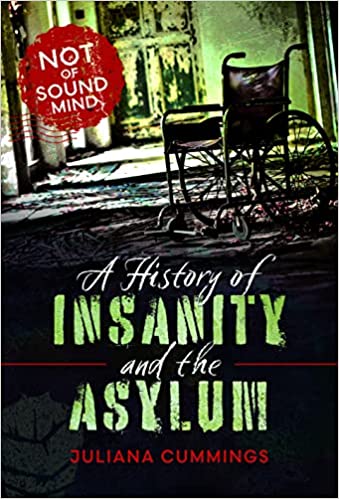Arpan K. Banerjee
Solihull, UK
 |
| Cover of A History of Insanity and the Asylum by Juliana Cummings. |
Mental health topics have long been a source of fascination. In this new book, author Juliana Cummings explores the history of insanity and asylums from the Middle Ages to the modern era, revealing the sometimes-shocking treatment of people with mental illness over the centuries. Although the book is written from a predominantly British viewpoint, European and American history is also addressed, making the book of interest to a wider audience.
In the opening chapter on early pioneers in mental health treatments, we are reminded that Hippocrates described mania, melancholy, insanity, paranoia, hysteria, and other terms still in use today. The causes of mental illness, however, eluded the early pioneers. Aristotle, of course, proposed an imbalance of the four humors as the cause of all illness. Galen believed that a predominance of black bile was associated with melancholy. These early pioneers believed that music and art had a role in the treatment of illness. Hippocrates felt that the soul could be healed through music, which would in turn heal the body. Music therapy is still used in the treatment of mental illness. First-century physician Areteaus of Cappadocia also proposed ideas about melancholy, although he also believed that hysteria was caused by a wandering womb. And the Roman scholar Cicero believed that mental instability was caused by moral failure.
In the ancient Islamic world, physician and philosopher Mohammed Ibn Zachariah Al-Razi was one of the first people in the world to write about mental illness. He looked after hospitalized patients with mental illness and was one of the first practitioners to use cognitive therapy. Born in Tehran in AD 855 and working in Baghdad, he believed that mental illness should not be treated differently from physical illness. He wrote over 200 books in his lifetime but sadly, only thirty-six remain today. In his work Liber Continens, he provided several explanations for mental illness.
In the Middle Ages in Britain, insanity was not well understood. Exorcisms were performed for demonic possession. In 1247, the Bedlam Hospital was established in London. Initially meant to be a refuge for the poor, by the fourteenth century it primarily was a specialist hospital for the treatment of so-called “lunatics.” Little useful advancement occurred in the treatment of mental illness in the sixteenth and seventeenth centuries but it included purging and the administration of opiates. Astrological influences were also considered in the treatment of madness, resulting in the unusual bedfellows of astrology and medicine in the late Middle Ages.
The first great British book on psychiatry is considered to be Robert Burton’s Anatomy of Melancholia published in 1621. Burton himself suffered from the condition and believed that if black bile in humans was excessive, one became a chronic melancholic. Melancholy, or depression as we know it today, was common in this era.
The early nineteenth century saw the extensive building of asylums in Britain made possible by an 1808 Act of Parliament. These early asylums often resulted in patients being forced into slave labor under cruel and inhumane conditions. They were gradually closed in the late twentieth century with advances in psychopharmacology and community-based treatment of mental illness.
One of the fathers of modern psychiatry was Emil Kraepelin, a German psychiatrist who was the first to differentiate between schizophrenia and manic depression as causes of psychosis. He was also a pioneer in the use of psychiatric drug therapy. Kraepelin was somewhat critical of Sigmund Freud’s psychoanalytical theories, which had revolutionized psychiatric treatment in the early twentieth century. In the latter part of the century, the writings of Hungarian psychiatrist Thomas Szasz serve to remind us that not all mental health professionals believed in the direction and evolution of modern mental health treatment.
A History of Insanity and the Asylum is a fascinating, well-written book on a complex and often taboo subject. It illuminates the often-cruel history of psychiatric treatment but also highlights the remarkable advances that have been made.
A History of Insanity and the Asylum: Not of Sound Mind
Juliana Cummings
Pen and Sword Books Ltd, 2023
ISBN 9781399012140
DR. ARPAN K. BANERJEE qualified in medicine at St Thomas’s Hospital Medical School, London. He was a consultant radiologist in Birmingham 1995–2019. He was President of the radiology section of the RSM 2005–2007 and on the scientific committee of the Royal College of Radiologists 2012–2016. He was Chairman of the British Society for the History of Radiology 2012–2017. He is Chairman of ISHRAD. He is author/co-author of papers on a variety of clinical, radiological, and medical historical topics and seven books, including Classic Papers in Modern Diagnostic Radiology (2005) and The History of Radiology (OUP 2013).
Spring 2023 | Sections | Psychiatry & Psychology

Leave a Reply